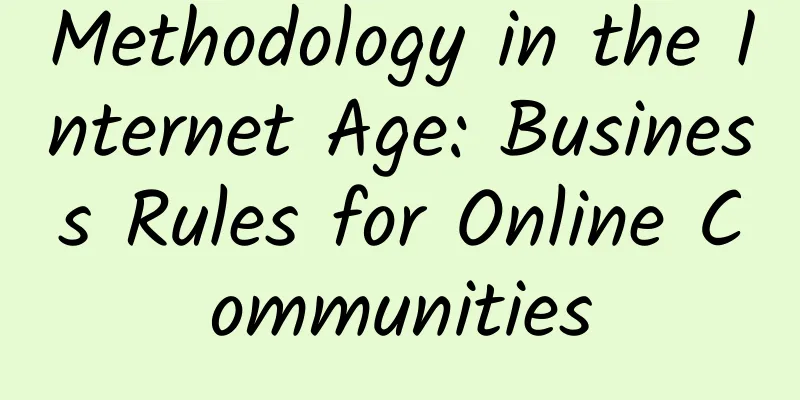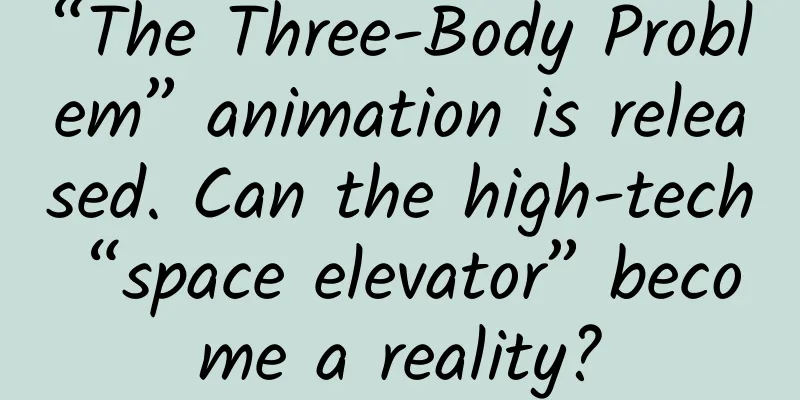Methodology in the Internet Age: Business Rules for Online Communities

|
Since the development of the Internet, people have been talking about the eyeball economy and the fan economy, but it seems that no one has systematically summarized the establishment and operation of communities. People are more analyzing individual cases, such as how Lao Luo is, how logical thinking is, etc. This article will try to systematize the establishment and development of communities. Types of communities and motivations for launching Communities are classified, which may seem like nonsense, but just like the biological world appears more orderly after the existence of phyla, classes, orders, families, genera and species, if we want to understand communities, we must first understand classification. If we divide communities by their supporting points, they can be divided into product-based communities and sentimental communities. Xiaomi is a typical product-based community, which relies on a specific product; Douban is a typical sentimental community, where young people can express their feelings. Celebrity communities are somewhere in between, but they tend to lean more towards the former. This may sound a bit harsh, but in fact, for this type of community, Chris Lee and Xiaomi phones are equivalent, both of which are equivalent to a product. No matter what kind of community it is, there will be a sense of belonging, and belonging is first of all an emotion. This emotion may be due to taste or philosophy, but it is basically exclusive. This means that when you choose a certain type of community, you have also chosen its attributes and scale, which are basically irreversible and cannot be broken through. Resetting means that the literary youths are basically literary youths, and it is unlikely to be transformed into the second dimension; breaking through means that the literary youths are only for literary youths, and the number of literary youths determines the size of your community. Don't expect it to be universal. This characteristic is still a little different between product-based communities and sentimental communities, because product-based communities can attract middle-class people because of their functions, so the more successful the product, the larger the community appears, but in fact it is a false momentum and is not that large; sentimental communities have fewer middle-class people, because the more exclusive this type of community is, the more distinct its personality is, and the higher its popularity will be. The higher the popularity, the greater the strength of the connection between people in the community, and the greater the possibility of survival. The affiliation of product-based communities must first fall back to the product, which in fact excludes the possibility of many products building their own communities, because many products do not inherently have the structure of building their own communities. This is particularly worthy of warning today when the Xiaomi model is hot. Toy makers and condom makers may try to clone the Xiaomi model, but most of these products obviously do not have the connotation to support a community. It is not difficult to judge whether the so-called connotation is sufficient: first, the topic should have a certain diversity. It is annoying after all if people talk about how much money you make when they meet each other; second, the topic itself should be a little interesting. Obviously, general toys (Lego is an exception) and condoms do not meet these two standards. At this point, I strongly suspect that the Internet needs a shared, cross-cutting community. Sharing means that this community can serve multiple products, and cross-cutting means that this community should be based on something that can be universally applied to various products. For example, Luo Yonghao's craftsmanship can actually be used in many products. The affiliation of sentimental communities is obviously sentiment. Hipsters, rationalists, and brain-dead people are all equivalent in sentiment. It seems that there are as many communities of this kind as there are preferences, but that is not the case. As long as you really like a product and think about it, anyone can figure something out. However, sentiment is more spiritual, and both starting and maintaining it require an extra push. Such communities only exist because of people's activities, so why do people participate in communities? This requires at least a sustained enthusiasm and some time, and it cannot be utilitarian. Once it is utilitarian and sells things to make money, it deviates from the original intention, and then the community is prone to collapse. Understanding this point will understand why everyone always focuses on the post-90s generation and why it is easy to establish a hipster community. Young people have excess energy and naturally need a way to vent, while literary youths have a natural desire to express themselves. The former is easy to understand. When a kitten is just born, it will pounce on anything it sees, catch dragonflies, catch mice to play with, and even catch its own tail. When it becomes an old cat, it will only move when it is particularly necessary, such as when it is hungry. It may not be interested in a mouse passing by. Is it easier to build a community when it is a kitten or when it is an old cat? This is why the post-90s and post-00s are important. They are more active and more easily attracted to new things. Animals naturally become less active as they age, but humans are more amazing because they have free will. Some people can go against nature. I remember Samuel Ullman wrote a famous prose poem called "Youth", in which one line is: Youth is full of vigor and vitality, courage overwhelms cowardice, and aggressiveness overwhelms complacency. This kind of vigor and vitality is found in men in their twenties and even more so in men in their sixties. Getting older does not mean getting old; only when ideals are abandoned does one fall into old age. At least some people are like what the poem says, their vitality does not disappear with age. They used to be called intellectuals, or literary youths if we narrow the scope. Literary youths tend to pay attention to issues beyond reality and like to express themselves, which is the necessary nourishment for sentimental communities. Of course, people are greedy, angry, and ignorant, and they can always find the right entry point. Not all types of communities need literary youths. What I want to talk about here is the source of personnel and the basis for their survival. There are differences between product-based communities and sentiment-based communities, but they can be superimposed. For example, in the open source community, there are Linux, Apache, etc., which can be regarded as product-based communities, but at the same time they are all under the spirit of open source. However, these two communities do have differences in operation, which will be discussed below. Cultivation of community The entry requirements for product-based communities are relatively high (you need a good product), but it is relatively easy to start because there are specific things to rely on. At this time, the key is the product itself, and the community here serves the product. This is particularly evident in open source projects. For example, a project called AngularJS is open source, and this project can greatly improve the response speed, so many people will use it. During the use process, they will inevitably interact around how to use it, what needs to be corrected, in what situations it is suitable, and what advantages it has compared to other similar projects. These things are the best motivation for the community to continue. At this time, the life cycle of the community is tied to the life cycle of the product. Imagine if Linux exits the stage of history, then the Linux community will no longer exist. Sentimental communities are just the opposite. They are easier to start, but more difficult to expand. Even if you can start a community from a hobby like fishing, it is not so easy to keep it going when attention resources become increasingly scarce. There are two ways to start a sentimental community. One is to directly bind it to specific things, such as fishing, reading, and Chinese studies. In this way, the focus can be clearer, but the scope will be limited, and ultimately the number of people attracted will not reach a certain scale, and the community will slowly wither; the other is to start with surreal things such as ideals, such as grand narratives such as "bringing truth to mistakes and trust to doubts". In this way, there is a lot of room for exploration, but it must be started with specific things. In order for any community to survive, the number of people it attracts must exceed a certain value, otherwise the community will easily wither. The number of people required is related to the level of spiritual appeal. The British Moonlight Society can also be regarded as a community, but it has only a dozen people, and it also has a huge impact. The spiritual appeal is too high, so this result is achieved, but most of the time it doesn't work. If it is a life chat type, at least 50 extremely suitable core personnel are needed to plant the seeds of survival. This should be a survival red line. From the perspective of how communities recruit people, there are two main types: one is from online to offline, and the other is from offline to online. It is easier for product-based communities to move from online to offline, while the purely online model of sentimental communities has been consumed by Douban, Zhihu, and Guokr. However, the offline-to-online model has not been better verified, and there should be more room. The disruptive innovation training club is a verification, but there is still a long way to go in the future. The model from offline to online may be limited in the speed of development, but the potential value of this model may be greater. This model makes it easier to build strong connections between people. We talk too much about the Internet, and it seems that we have overlooked the basic characteristics of biology. Before the Internet developed to the level of The Matrix, people spent most of their time in real space. In order to continue to grow and develop, the community needs to consider more things in terms of organizational methods. Product-based communities are more dependent on the product itself, and the next topic should be more applicable to sentimental communities. If a community wants to grow and develop, it must do something together. Simple chatting and discussion have very low requirements for infrastructure, but they can only establish shallow connections and are only suitable for literary youths. Other types of communities need to do something specific together. In this process, people can establish closer connections. In order to do something, you need support. You can refer to the operating model of the open source community. This model has three key points: 1. Manage the resources of open source projects on a global scale through the Internet. For example: describe the latest progress of the project, project documents, links to available versions, etc. through the homepage, which usually acts as a guide; manage the project code in a unified manner through the code repository; discuss issues through the mailing list; track various defects in the software through the bug tracking system; and write the main documents of the project through Wiki. 2. Introduce engineering practices that are conducive to loose organizational structures. For example, use test-driven methods to ensure code correctness; use pair programming and code review to ensure code quality. 3. Promote personnel participation in the project through an open personnel structure. For example, in Apache's operating model, there are several roles: Developer, Technical Expert (Committer), Project Management Committee members (Project Management Committees), Apache Software Foundation Board of Directors. When a developer makes enough effort and gains enough influence, the Project Management Committee will grant this person the title of Committer, and only Committers have write access to the code base. If the Committer's contribution is large enough, he or she may be elected to the Project Management Committee, and the chairperson of the Project Management Committee is the VP of the Apache Software Foundation. From this perspective, if you want the community to have deep collaboration, you probably need the following things: 1. Spiritual pursuit, traditionally called mission, such as code freedom. This is not mentioned above, but it is actually the starting point of everything. 2. A product that supports the community, such as a combination of website + APP. 3. A loose organizational structure to handle its own affairs. A key point in this regard is whether to separate the operation of the community from the management of the community. My point of view is that the management of the community should only belong to the people in the community, and the company is more suitable to set the initial rules (the role of God) and play the role of the executor of daily affairs (civil servants). 4. A loose way of doing things, such as resolving disputes through voting. With this kind of infrastructure, we need to do things other than chatting and discussing, otherwise it will not last long. This is circumstantial evidence that WeChat groups that rely solely on chatting often die out easily. 5. If the community is initiated by a company and the community itself is autonomous (the community has a loose structure and cannot be the same as a company, so it needs to be autonomous), then the issue of interest division needs to be dealt with. Simply put, if the profitable company allocates funds to the community's management agency according to a certain ratio, the management agency has the right to use the funds according to its own wishes. Conclusion This is the seventh article on methodology in the Internet era. This article is directly related to the first article on the superposition of quantum and Newtonian worlds , and the third article on learning hand-to-hand combat from Luo Yonghao . The spirituality of finding products is in a parallel relationship with this article, one article focuses on products, and the other focuses on communities. As a winner of Toutiao's Qingyun Plan and Baijiahao's Bai+ Plan, the 2019 Baidu Digital Author of the Year, the Baijiahao's Most Popular Author in the Technology Field, the 2019 Sogou Technology and Culture Author, and the 2021 Baijiahao Quarterly Influential Creator, he has won many awards, including the 2013 Sohu Best Industry Media Person, the 2015 China New Media Entrepreneurship Competition Beijing Third Place, the 2015 Guangmang Experience Award, the 2015 China New Media Entrepreneurship Competition Finals Third Place, and the 2018 Baidu Dynamic Annual Powerful Celebrity. |
<<: Supervision of food delivery O2O: How many “relevant departments” are there?
>>: Douban, the mobile Internet can no longer wait for your confusion
Recommend
How to get traffic from Tik Tok short videos
Tik Tok short video marketing is booming, how can...
Weibo Fans Advertising Optimization Tips!
I believe most advertisers are very familiar with...
Foshan WeChat used car mini program function, how much does it cost to develop a used car transaction mini program?
With the rise of "new energy" vehicles, ...
Different sleeping positions, different personalities? How do you sleep?
It is unreliable to judge a child's personali...
Suzhou Restaurant Kitchen Mini Program investment price inquiry, how much is the Suzhou Restaurant Kitchen Mini Program investment price?
The advantages of WeChat mini program investment ...
Understand Toutiao’s information flow ads in one article!
As the largest information flow platform at prese...
These new media operation tools are awesome!
As an Internet person, in addition to being able ...
In-depth: Momo, Weibo and Kuaishou, the three video giants will eventually face off
Weibo has a market value of 17.2 billion yuan, Mo...
A 4-year bidding veteran: Sharing experience on creating new accounts, keyword optimization, and creative optimization!
Before I knew it, Feng Chao from Dongguan SEM has...
Is strabismus just "crossing the eyes"? Doctors remind you to pay attention to these things
“ "Doctor, my child's eyeballs are not i...
How to permanently turn off system updates on your phone? Just turn off these four switches and you can easily do it
After using our mobile phones for a while, we wil...
Cable TV was surpassed by broadband and then by Internet TV
Cable TV was once the largest form of home entert...
Liu Yang portrait 2021
Liu Yang Portrait Retouching 2021 Resource Introd...
How to divert Douyin traffic to the private traffic pool?
Traffic acquisition has always been a difficult p...
How to quickly promote App for beginners
With the rapid rise of mobile Internet, app devel...









